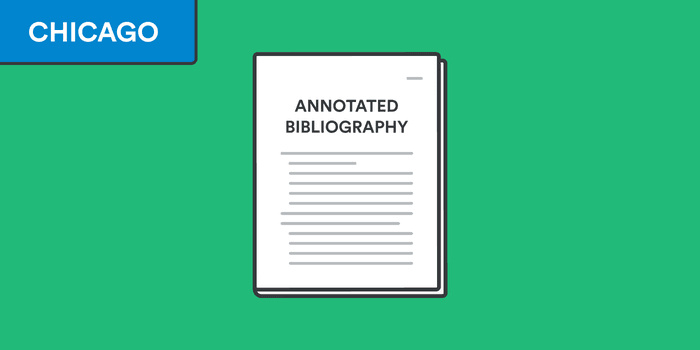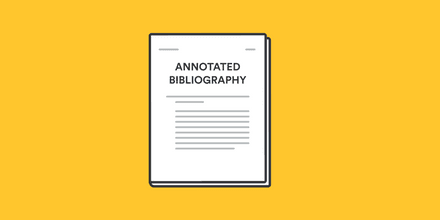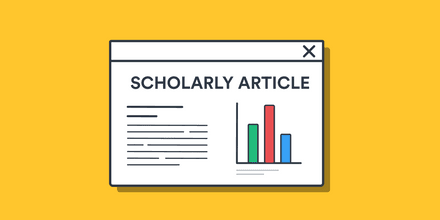
A Chicago annotated bibliography includes citations for the sources you are using and an annotation summarizing and/or evaluating each source. In this article, we define what an annotated bibliography is and offer tips for formatting one in Chicago style. We also include a Chicago citation example and a sample annotation.
What is an annotated bibliography?
A annotated bibliography is a list of citations for books, journals, periodicals, websites, articles, or other sources, accompanied by a descriptive paragraph that summarizes and evaluates the source. The descriptive paragraph is called an annotation.
Descriptive paragraphs typically range between 100 and 300 words. Ultimately, an annotated bibliography informs the reader about the source's accuracy, quality, and relevance to your subject.
How to format an annotated bibliography in Chicago style
An annotated bibliography in Chicago style essentially contains two items: a citation for each source and an annotation. In this section, we discuss how to format the citation and what to include in the annotation.
The citation
Start by formatting the citation in correct Chicago style. Chicago-style citations come in two varieties: the notes and bibliography system and the author-date approach.
The notes and bibliography system is more common in the humanities, while the author-date system is used primarily in the sciences and social sciences. However, for an annotated bibliography in Chicago style, you will most likely be asked to use only the bibliographic reference format from the notes and bibliography system.
The elements of a bibliographic citation in Chicago style include:
- the author’s name in reverse order
- the title of the source
- publication information
In the next section, we provide an example of a correct Chicago citation for a source in an annotated bibliography.
The annotation
After citing the source, write a concise annotation, summarizing the source’s central argument and evaluating its credibility and relevance to your research. In most cases, an annotation ranges between 100 and 300 words.
An annotation can include several items:
- a brief summary of the source, especially its main argument
- the strengths and weaknesses of your source
- the source’s relevance to your research topic
- a brief discussion of the relationship between the source and other studies in the field
- information about the author’s background
After summarizing the source, you should evaluate it. For instance, is the source peer-reviewed? What are the author’s credentials? What is the purpose of the source? You can use one of several evaluation methods, like CRAAP (currency, relevance, authority, accuracy, and purpose), to determine if a source is credible.
Finally, depending on the assignment’s guidelines, you should include some explanation of the source’s relevance to your research project. How will you use the source? How will your research benefit from its insights?
Example entry for an annotated bibliography in Chicago style
Davidson, Hilda Ellis. Roles of the Northern Goddess. London: Routledge, 1998.
Davidson's book provides a thorough examination of Northern Europe's major roles associated with several pagan goddesses. Some roles in everyday life include agriculture, hunting, domestic art like weaving, and death. In this book, the author discusses relevant archaeological evidence, previous research, and patterns of rituals and symbols. The book includes several photographs of relevant artifacts.
This Chicago-style annotation from Purdue University’s Online Writing Lab (OWL) is a single paragraph summarizing the book. In a longer annotation, you would evaluate the source’s credibility and relevance, in addition to summarizing it.
Chicago annotated bibliography tips
1. Review your instructor’s guidelines for the annotated bibliography.
Instructors will often assign an annotated bibliography as part of a larger research project. To best understand what your instructor expects, be sure to read the assignment guidelines. If you’re not sure about something, ask your instructor for clarification as soon as possible.
2. Take the time to really familiarize yourself with your sources.
You should read each source carefully before writing an annotation. Take good notes, so you can easily summarize the main argument of the source. If you’re unsure about the best strategies for reading academic sources, take a look at our guide on how to read a scholarly article.
3. Save time by using a citation generator.
To quickly format your citations, try BibGuru’s Chicago citation generator. This will save you time and enable you to focus more deeply on writing your annotations.
4. Use CRAAP or another method to evaluate each source.
You can use CRAAP (currency, relevance, authority, accuracy, and purpose) or the six questions words (who? what? when? where? how? and what?) to evaluate whether a source is credible.
A source is likely credible if the tone is objective, the author is an expert in their field, and it is peer-reviewed. Take a look at our guide on finding, evaluating, and citing scholarly sources to learn more about these methods.
5. Use clear, concise, and correct language in your annotation.
You should always try to use language that is clear, concise, concrete, and correct when you write your annotations. As examples of academic writing, annotations should follow the typical conventions.
This doesn’t mean that your annotation needs to be full of jargon or “big words.” Instead, use as few words as possible to make a point. And, be sure to check that your grammar and spelling is correct.
Frequently Asked Questions about annotated bibliographies in Chicago style
🍎 How do you write an annotated bibliography in Chicago style?
An annotated bibliography includes a citation and an annotation. In your annotation, you’ll want to provide a brief summary of the source, an assessment of its credibility, and how the source will benefit your research.
😊 What are the 3 parts of an annotated bibliography?
Your annotated bibliography needs to include a citation, as well as a summary and evaluation of the work. These three parts should be present for every source.
🤼 How long is a bibliography in Chicago style?
The length of your bibliography will depend on the number of sources you’re required to use and the type of assignment. Annotated bibliographies for many English or writing classes feature around 8-10 sources.
🎽 How do you start an annotated bibliography?
To start an annotated bibliography, create a correctly formatted citation for each source, then write out the annotations. To quickly format your citations, try BibGuru’s Chicago citation generator.
📌 What is the spacing for a Chicago annotated bibliography?
Typically, an annotated bibliography in Chicago style uses 1-inch margins and double-spacing for entries.


